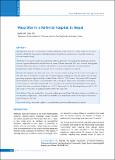Please use this identifier to cite or link to this item:
https://hdl.handle.net/20.500.14356/1868| Title: | Wasp Bite in a Referral Hospital in Nepal |
| Authors: | Sigdel, M R Raut, K B |
| Citation: | SigdelM. R., & RautK. B. (2014). Wasp Bite in a Referral Hospital in Nepal. Journal of Nepal Health Research Council. https://doi.org/10.33314/jnhrc.v0i0.398 |
| Issue Date: | 2013 |
| Publisher: | Nepal Health Research Council |
| Article Type: | Original Article |
| Keywords: | Allergic interstitial nephritis Acute renal failure Hemolysis  rhabdomyolysis Wasp bite |
| Series/Report no.: | Sep-Dec, 2013;398 |
| Abstract: | Abstract Background: Wasp bite is an important occupational hazard in Nepal. Almost 25% of the victims die. This study aimed to identify the demographics, clinical presentation, hospital course and outcome of wasp bite victims in a referral hospital in Nepal. Methods :A retrospective study was conducted in Tribhuvan University Teaching Hospital, Kathmandu. Medical records of patients admitted for wasp bite between January 2008 and December 2012 were reviewed. Demographic, clinical and laboratory data were collected and their effects on outcomes in the form of death, duration of hospitalization, number of dialysis sessions and time to resolution of oliguria were analyzed. Results: All 18 patients came from rural areas, 13 (72%) were farmers, mean age was 39.6 ±16.7 years (range 7 to 69). Most bites occurred between August and November. Oliguria, vomiting, red urine and jaundice were the main presenting symptoms; oliguria developed within 48 hours of bite in 17 (94 %) cases. Nine patients (50%) required blood transfusion. All developed acute renal failure (ARF) and required dialysis, mean hemodialysis session being 7.4±5.3 (range 1 to 20). Sixteen patients (89 %) received steroid for presumed interstitial nephritis. One patient expired. Mean time to resolution of oliguria was 15.9±9.5 days (range 2 to 35). Mean hospital stay was 18.7±13.4 days (range 1 to 46), those having higher number of bites had longer stay. Conclusions: Wasp bite mostly affects farmers of working age in rural Nepal. Hemolysis and acute renal failure are two important complications. Timely dialysis in established acute renal failure and steroid in suspects of interstitial nephritis improves survival. Keywords: allergic interstitial nephritis; acute renal failure; hemolysis;  rhabdomyolysis; wasp bite. |
| Description: | Original Article |
| URI: | http://103.69.126.140:8080/handle/20.500.14356/1868 |
| ISSN: | Print ISSN: 1727-5482; Online ISSN: 1999-6217 |
| Appears in Collections: | Vol. 11 No. 3 Issue 25 Sep - Dec, 2013 |
Files in This Item:
| File | Description | Size | Format | |
|---|---|---|---|---|
| 398-Article Text-481-1-10-20140207.pdf | Fulltext Download | 527.91 kB | Adobe PDF |  View/Open |
Items in DSpace are protected by copyright, with all rights reserved, unless otherwise indicated.
